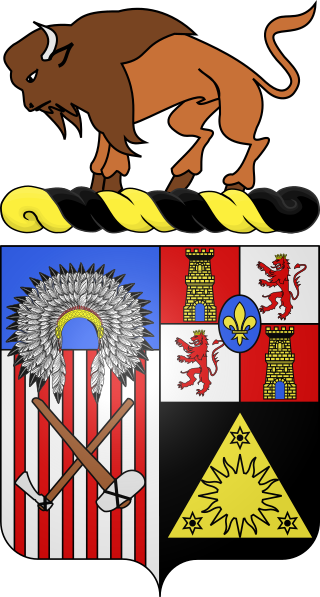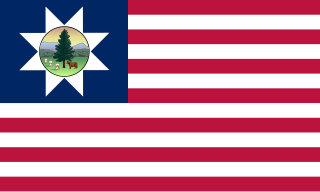
List of military units raised by the state of Vermont during the American Civil War.

List of military units raised by the state of Vermont during the American Civil War.
|


XXII Corps was a corps in the Union Army during the American Civil War. It was created on February 2, 1863, to consist of all troops garrisoned in Washington, D.C., and included three infantry divisions and one of cavalry. Many of its units were transferred to the Army of the Potomac during Grant's Overland Campaign.

The Vermont National Guard is composed of the Vermont Army National Guard and the Vermont Air National Guard. Together, they are collectively known as the Green Mountain Boys. Both units use the original Revolutionary War-era Flag of the Green Mountain Boys as their banner. In 2009, they had 2,600 members.

William W. Wells, Jr. was a businessman, politician, and general in the Union Army during the American Civil War who received a Medal of Honor for gallantry at the Battle of Gettysburg.

The 10th Cavalry Regiment is a unit of the United States Army. Formed as a segregated African-American unit, the 10th Cavalry was one of the original "Buffalo Soldier" regiments in the post–Civil War Regular Army. It served in combat during the Indian Wars in the western United States, the Spanish–American War in Cuba, Philippine–American War and Mexican Revolution. The regiment was trained as a combat unit but later relegated to non-combat duty and served in that capacity in World War II until its deactivation in 1944.

During the American Civil War, the State of Vermont gave strong support to the Union war effort, raising troops and money. According to Rachel Cree Sherman:
By the spring of 1865 Vermont was devastated, having sent one tenth of its entire population to war, with a loss of over 5,000 lives to battle, wounds, and disease. The state had dedicated nearly $10 million to support the conflict, half of that amount offered up by towns with no expectation of recompense.

The 12th Vermont Infantry Regiment was a nine months' infantry regiment in the Union Army during the American Civil War. It served in the eastern theater, predominantly in the Defenses of Washington, from October 1862 to July 1863. It was a member of the 2nd Vermont Brigade.

The 16th Vermont Infantry Regiment was a nine months' infantry regiment in the Union Army during the American Civil War. It served in the eastern theater, predominantly in the Defenses of Washington, from October 1862 to August 1863. It was a member of the 2nd Vermont Brigade.

The 13th Vermont Infantry Regiment was a nine months' infantry regiment in the Union Army during the American Civil War. It served in the eastern theater, predominantly in the Defenses of Washington, from October 1862 to August 1863. It was a member of the 2nd Vermont Brigade.

The 1st Vermont Cavalry Regiment was a three years' cavalry regiment in the Union Army during the American Civil War. It served in the Eastern Theater from November 1861 to August 1865, in the Cavalry Corps, Army of the Potomac.

Peter Thacher Washburn was a Vermont lawyer, politician and soldier. A veteran of the American Civil War, he served as the 31st governor of Vermont as a Republican from 1869 to 1870, and was the second Vermont Governor to die in office.

Henry Eugene Davies was an American soldier, writer, public official and lawyer. He served in the Union Army as a brigadier general of volunteers in cavalry service during the American Civil War and was promoted to the grade of major general of volunteers at the end of the war. Davies was one of the few nonprofessional soldiers in the Union cavalry in the East to be promoted to the grade of general. He led his brigade in several major battles, especially during the Overland Campaign, the Battle of Trevilian Station, the Siege of Petersburg and the Appomattox Campaign at the end of the war.

The area that eventually became the U.S. state of Montana played little direct role in the American Civil War. The closest the Confederate States Army ever came to the area was New Mexico and eastern Kansas, each over a thousand miles away. There was not even an organized territory using "Montana" until the Montana Territory was created on May 26, 1864, three years after the Battle of Fort Sumter. In 1861, the area was divided between the Dakota Territory and the Washington Territory, and in 1863, it was part of the Idaho Territory.

The 86th Field Artillery Regiment is a inactive parent field artillery regiment of the United States Army, last represented in the Vermont Army National Guard by the 1st Battalion, 86th Field Artillery Regiment. Perpetuating the Vermont Light Artillery Batteries of the American Civil War and subsequent Vermont artillery units, the regiment was organized following World War II as the 206th Field Artillery Battalion in the Vermont National Guard. The 206th saw active service in Germany with the 43rd Infantry Division during the Korean War, and became the 124th Artillery, a Combat Arms Regimental System parent regiment, in 1959. Represented by the 1st Howitzer Battalion, 124th Artillery, the regiment was renumbered as the 86th Artillery in 1964 when the 1st Battalion became the brigade artillery battalion of the 86th Armored Brigade. The 1st Battalion served in that role with the brigade for much of the rest of its existence.

The 1st Maryland Cavalry Regiment was a cavalry regiment of the Union Army during the American Civil War.

The 18th Pennsylvania Cavalry Regiment was a cavalry regiment of the Union Army during the American Civil War. The regiment was present for 50 battles, beginning with the Battle of Hanover in Pennsylvania on June 30, 1863, and ending with a skirmish at Rude's Hill in Virginia during March 1865. A majority of its fighting was in Virginia, although its first major battle was in Pennsylvania's Gettysburg campaign. It was consolidated with the 22nd Pennsylvania Cavalry Regiment on June 24, 1865, to form the 3rd Provisional Pennsylvania Cavalry Regiment.